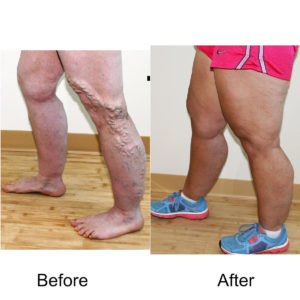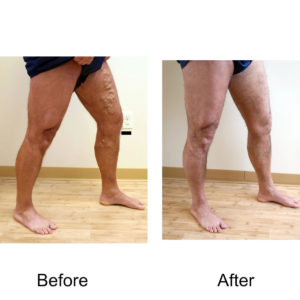Best Treatments for Varicose and Spider Veins
Varicose and spider veins are common vascular conditions that affect a significant portion of the population and many patients wonder what the best treatments for varicose and spider veins may be. In some cases vein problems may simply be cosmetic, but many times they are more than just a cosmetic concern, causing symptoms like aching, pain, heaviness, fatigue, itching, burning, cramps, restlessness, throbbing and swelling. Several treatment options are available, ranging from conservative measures to more invasive procedures, and the choice of treatment depends on the severity of the condition, the patient’s preferences, and the physician’s recommendations.
Conservative Treatment Measures for Varicose and Spider Veins:
Lifestyle Changes and Self-Care: For mild cases of varicose and spider veins, lifestyle changes and self-care practices can help alleviate symptoms and slow down the progression of the condition. Some recommended self-care measures include:
Regular Exercise:
Engaging in low-impact exercises like walking, swimming, or cycling can promote better blood circulation and reduce pressure on the veins.
Weight Management:
Maintaining a healthy weight can reduce the strain on the veins, thus decreasing the risk of developing varicose and spider veins.
Elevation:
Elevating the legs above heart level for short periods during the day can help improve blood flow back to the heart and relieve symptoms.
Compression Stockings:
Graduated compression stockings provide external pressure to the legs, supporting the veins and helping blood flow more efficiently.
Avoiding Prolonged Sitting or Standing:
Frequent movement and avoiding long periods of sitting or standing can prevent blood pooling in the legs.
Medical Treatment Options for Varicose and Spider Veins:
If conservative measures have failed, or if improvement in appearance is the main concern, medical intervention will be needed. The best current treatment options include:
Traditional Sclerotherapy and Ultrasound-Guided Foam Sclerotherapy:
Sclerotherapy is a common treatment for spider veins and small varicose veins. During this non-surgical procedure, a solution (most commonly a detergent or soap) is injected directly into the affected veins, causing them to collapse and eventually fade away. The treatment is relatively quick, with minimal discomfort and downtime. However, multiple sessions may be required for optimal results. More recently, Ultrasound-Guided Foam Sclerotherapy has come into wider use, as it is more effective (foam increased the efficacy of the medication by about four-fold), and the use of ultrasound during the procedure takes away any guess work, as the foam is highly echogenic, essentially replicating a venogram and making assessment of treatment coverage very objective.
Endovenous Thermal Ablation Procedures:
Endovenous Laser Ablation (EVLA) or Radiofrequency Ablation (RFA) are minimally invasive procedures that are effective for treating larger varicose veins and are mainly used to treat the Great or Small Saphenous Veins. Under local anesthesia, a thin laser fiber or catheter is inserted into the damaged vein. The laser or radiofrequency energy heats and seals the vein, causing it to collapse and be gradually reabsorbed by the body. EVLA and RFA offer excellent outcomes and generally have much shorter recovery periods compared to traditional vein stripping surgery.
Cyanoacrylate:
One of the more recent treatments for varicose veins is the use of medical super-glue (cyanoacrylate) to physically shut down and seal the main defective vein. VenaSeal Adhesive Glue, is a medical grade glue that is used to shut the main saphenous vein in the thigh. Once the vein has been glued shut, it will undergo a process of hardening (sclerosis) and will be gradually absorbed by the body. The procedure is minimally invasive.
Phlebectomy:
Phlebectomy, also known as ambulatory phlebectomy or microphlebectomy, is a surgical procedure to remove larger varicose veins through tiny incisions. The procedure is usually done under local anesthesia, and patients can return home shortly after. Phlebectomy is particularly suitable when there is a limited number of bulging veins close to the skin’s surface.
MOCA (Mechanical Occlusion Chemically Assisted Ablation):
Clarivein is a relatively newer treatment option that combines mechanical agitation and sclerosant infusion. A rotating catheter is inserted into the damaged vein, delivering a sclerosant while simultaneously agitating the vein’s lining. This procedure results in vein closure and may be less painful than traditional sclerotherapy, as it doesn’t require multiple needle sticks.
Laser Therapy:
For smaller spider veins, laser therapy can be an effective treatment option. The laser emits focused light energy that targets and destroys the veins, causing them to fade over time. Like sclerotherapy, multiple sessions may be necessary for optimal results.
High-Intensity Focused Ultrasound (HIFU):
HIFU is a newer treatment option for varicose veins that utilizes ultrasound energy to heat and seal the damaged veins. It is a non-invasive procedure that does not require incisions, making it relatively comfortable and requiring minimal recovery time.
Vein Stripping (Surgical Ligation and Stripping):
Traditional vein stripping involves surgically removing the affected veins through incisions. This invasive procedure is now less common due to the availability of minimally invasive options, high cost, high failure rates, and high associated risks. Unfortunately, some hospital-based physicians continue to perform this procedure, despite the fact that other safer, more effective procedures are available.
So What is the Best Treatment Option for You?
In conclusion, the best treatment for varicose and spider veins depends on the severity of the condition, the patient’s medical history, and their preferences. Many individuals find relief through lifestyle changes and self-care practices. For those seeking more significant improvement or with severe symptoms, various minimally invasive procedures are available. It’s essential to consult with a vein specialist like Dr. Erdman at Madison Medispa to determine the most suitable treatment plan for your individual case.


